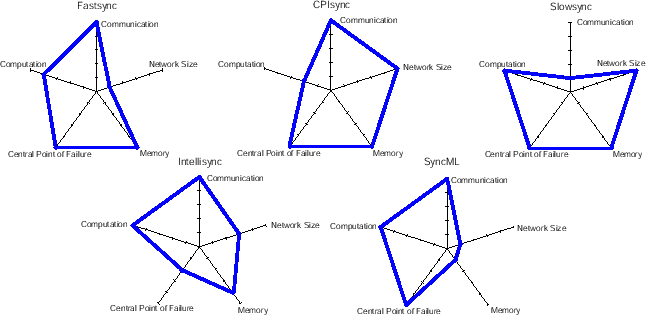



Next: PDA Synchronization
Up: Contemporary Synchronization Technologies
Previous: CPISync
Contents
Putting it together
Each of the synchronization protocols described above scale in some respects while not in others. In
order to highlight these differences between them
Figure 2.8 shows a set of radar diagrams that
highlight the scalability characteristics of the protocols
qualitatively. Each protocol is evaluated according to the
following criteria:
Communication - This refers to the amount of data
exchanged between the synchronizing devices. Communication is
usually important because of two reasons. First, it directly
affects the time needed for synchronization and secondly it has a
bearing on resources used while synchronizing such as the battery
consumed in mobile devices. Both these factors directly affect the
user. Slowsync for example transfers the entire database from the
PDA to the PC for synchronization and scores poorly on this count
as shown in Figure 2.8.
Network size - The network size is the number of
devices on the network that can synchronize. That is, the
scalability of the protocol with the number of devices that
synchronize with each other. The point to note about any
synchronization protocol is the amount of information it has to
store to synchronize with each device on the network. SyncML
requires too much memory to store synchronization information.
Fastsync does not allow multi-device synchronization.
Robustness - The robustness here is characterized by
the nature of the protocol itself - whether it is resilient to
device failure in the network. Intellisync scales poorly because
there is a central point of failure - a central intellisync server
(see Figure 2.6) in the network whose failure
will lead to disruption of the whole synchronization service for
every device on the network.
Computation - This is the amount of computation the
devices need to do in order to synchronize. Mobile devices and
PDAs generally have weak processors (though this is changing).
CPISync is computationally intensive, though most of the
computation can be transferred to the PC, saving the PDA slow and
intensive number crunching.
Memory - Memory is a precious resource on PDAs. Though
the amount of memory on newer PDAs is rapidly increasingly, PDA
memory is shared between the data and RAM. There is no separate
secondary storage or ``hard disk" to store data. A synchronization
protocol that takes up minimum real estate in the PDA memory is
always a better choice. SyncML scores poorly on this count because
it requires each device to keep status flags for every other
device in the network.
The ideal protocol with respect to the above criteria will
correspond to the `full' pentagon as shown in
Figure 2.2. It can possibly achieved by an
amalgamation of the desirable characteristics of the protocols
discussed in the previous section.
Figure 2.8:
Scalability strengths and weaknesses of
different synchronization protocols. An absolute qualitative scale
is used in which high values indicate strengths and low values
indicate weakness.
 |




Next: PDA Synchronization
Up: Contemporary Synchronization Technologies
Previous: CPISync
Contents
Sachin Kumar Agarwal
2002-07-12

